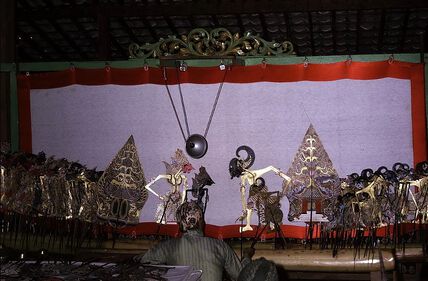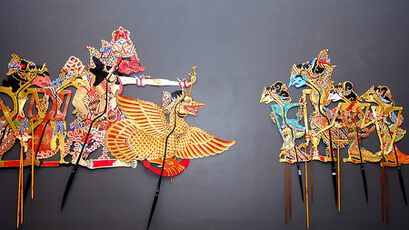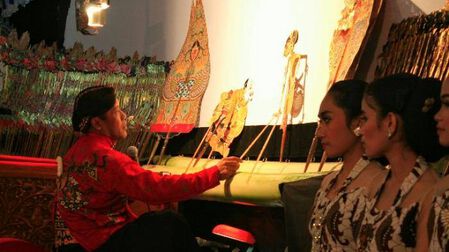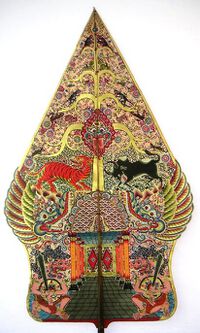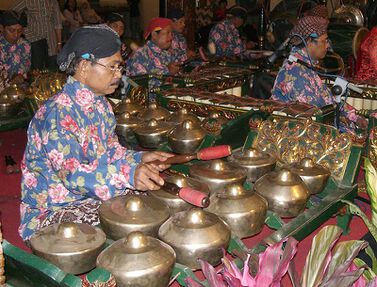Wayang Kulit Puppets
To create a new page, enter a unique page name below.
If a page with that name already exists, you will be sent to a form to edit that page.
For existing pages ... see category Wayang Kulit Puppets.
Fill in the form with the details of your image and save the page.
Wayang Kulit
In Javanese, wayang literally means "shadow" or "shade". The derived meaning of this word is a certain form of puppetry that uses shadow or light effects. Although wajang usually refers to shadow play using leather puppets (wayang kulit), the word is also used for performances with three-dimensional puppets (wayang golèk), with flat wooden puppets (wayang gedhog) and even for a play with silent actors - dancers (Wayang Wong). The condition for the latter is that the piece must be based on the Indian epics Ramayana and Mahabharata. The Indians have had a lot of influence on the Indonesians. Following this, the Indonesians have their own version of the epics, which are broadly similar to the original epics. Since 2003, Wayang Kulit has been included in the list of masterpieces of the oral and intangible heritage of humanity. A well-known Javanese wayang player is Slamet Gundono.
History
Javanese shadow play is very old. The oldest evidence of wayang playing is found in a Central Javanese inscription dating from the year 840, which mentions the word ringgit, which is a synonym of the word wayang. The word wayang itself was first mentioned in an inscription from 907. This inscription mentions a wayang player together with a dancer and a comedian. In literature we get the first mention of shadow play in the Old Javanese poem kakawin Arjunawiwaha, which is dated between 1028 and 1035. In wayang kulit (wajang koolit, literally "leather wajang(dolls)"), two-dimensional puppets — handmade from buffalo or goat hides — are used as parchment dolls with movable arms. A wayang kulit puppet has a highly stylized human shape. Of the many different styles of wayang kulit, the form practiced in Central and East Java is by far the most popular in Indonesia.
The puppets
The puppets in wayang kulit come in many sizes, depending on the characters they portray. Malay shadow play puppets typically measure at least 71 cm long and are at most 30.5 cm wide. A complete shadow theatre has between 160 and 200 puppets categorised into deities, warriors, ogres, hermits, monkeys, soldiers, princesses, weapons, animals and mountains. Most Malay shadow play characters only have one articulating limb, while a majority of Javanese and Balinese puppets have both arms articulated. The puppets are carved out of cowhide in ornate designs, and then beautifully painted with bright colours. Female cowhide is preferred as it is larger and softer.
Occasion
The traditional wayang display in Java is given as part of a celebration to mark an important event in the life of an individual or group. This could be a marriage, a circumcision, recovery from a serious and prolonged illness, completing a difficult study, promotion in one's social career, in general: achieving a difficult goal. In Bali, wajang displays are also performed at cremations. The wajang display serves to get through the communal night vigil, which is an unmistakable part of such a ritual festival (Javanese: slametan). The subject of the display must therefore always be appropriate. It is preferably chosen in such a way that the spectators can see a parallel with the living conditions of the person for whom the party is being given. The details of the chosen piece can be changed in such a way that the pasemon, the allusion to personal circumstances, becomes extra clear.
The dalang
The dalang (Javanese: dhalang) is the puppeteer practices with the wayang puppets in front of the kelir (screen). He manipulates all the puppets between a lamp and the screen to bring the puppet shadows to life. He also sings and gives signals to the orchestra. He is also the speaker for all the characters. He must be able to imitate all kinds of voices; from the genteel language of the princes to the rustic language of the people in the countryside. It goes without saying that this task is not for everyone. A dalang is a versatile and extraordinary person. First and foremost, he's an entertainer; it is not easy to entertain a large number of people. Furthermore, he must be physically strong, otherwise he would not be able to handle the strain of sitting with his legs crossed for nine hours. Without getting up until six o'clock the next morning (the performances often last all night), so also without going to the toilet. He also has to tap a kecrèk (rattle) almost incessantly with his right foot. He handles the puppets with both hands, gives them different voices, tells well-timed jokes and even sings occasionally. And in the meantime he controls the musicians, without anyone in the audience noticing. Most of the stories in the shadow plays of Java, Bali, the Malay Peninsula and mainland Southeast Asia are based on two well-known Hindu epics from India: the Mahabharata and the Ramayana.
Pause sign
The kayon, also called gunungan, is the most important tool in a wajang performance. The kayon is used at both Wayang Golek and Wayang Kulit. It is a shadow figure depicting the seat of the gods (Mount Semaru in Java) and the tree of life, which symbolizes the divinity of life. The kayon moves from right to left during a performance. The kayon has many functions. As a representation of the cosmic order of the universe, the puppet stands for a performance in the center of the screen, sometimes with the clown servant Semar behind it. Both are positioned on the puppeteer's side. The kayon brings the dolls to life. At the beginning of the performance, the dalang places the kayon to the side to symbolize that the performance has entered the mythical sacred world of shadows. During the performance, the kayon indicates changes of place or the emergence of an important personality. The kayon can also serve as a decor piece. It can represent a palace, a rock, a forest or a hermitage. The kayon can also represent a river, wind, fire and water, when the dalang makes the Gunungan move wildly across the screen. This is called gara-gara. During a conventional midnight performance the Gunungan is upright and in the last scene the Gunungan is on the left. Afterwards, the Gunungan is back in the middle of the screen.
Philosophy of the wayang game
Despite the more recent introduction of Islam and Christianity to Java, the philosophy and ethics espoused in the Mahabharata remain an important part of the social fabric and attitudes towards life in Java today. In fact; the wajang game and the philosophy behind it can be seen as connecting the many groups that Java has to offer.
Gamelan orchestra
The traditional gamelan orchestra accompanies the dalang playing the puppets on the same side of the screen. It plays out almost continuously at every company. It consists of a large series of bronze percussion instruments, tuned in two different ways, quite different in character; the two scales are called sléndro and pélog. Although a dalang never looks behind him, and almost never says a word to the players, each of them seems to know exactly what to do. How he communicates his intentions to the gamelan players is a study in itself in the field of non-verbal communication. Two musicians in the group have important functions in the unspoken communication between dalang and musicians: the drummer and the gender player.
More info:
The evolution of the gong in indonesian music
Video 1: Making a wayang kulit puppet
Video 2: The Wayang Puppet Theatre
